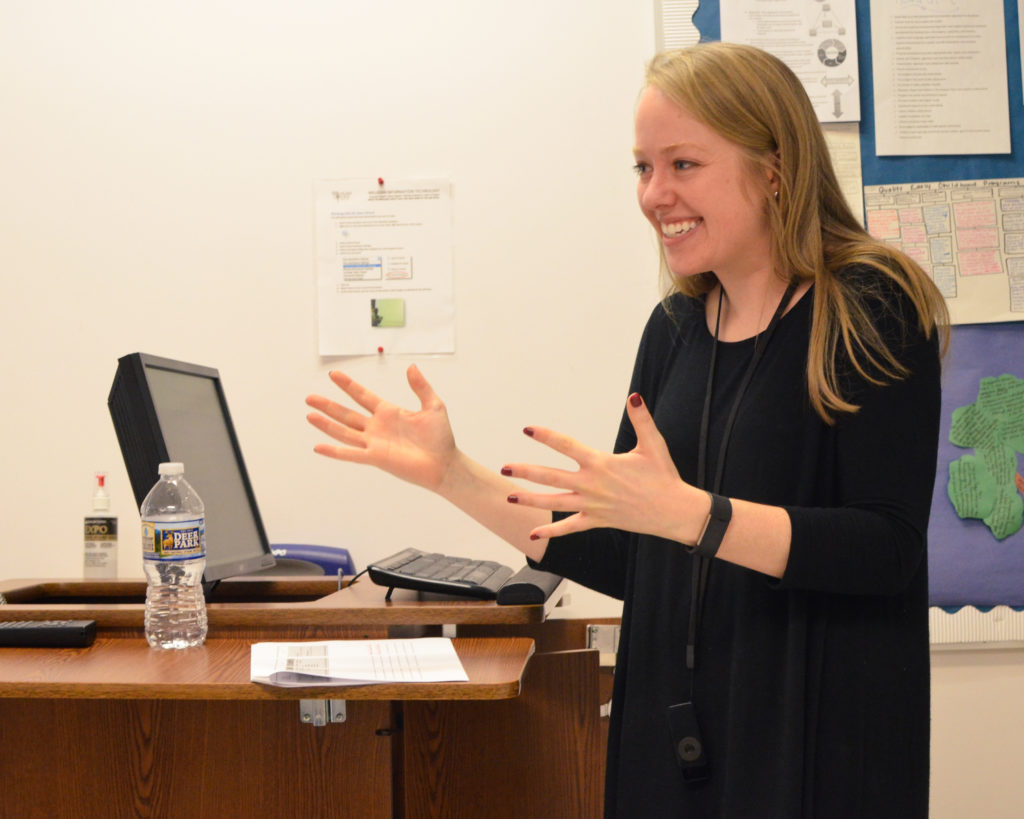This past Saturday, two local English as a Second Language teachers from the Johnson City district shared teaching tips with students in Milligan’s new ESL endorsement program. They openly addressed the 11 students seated in a u-shape in Clark 101.
Deborah Forster, who has been an elementary teacher for over 10 years and is renewing her teacher’s license, appreciated the real-life examples.
“It’s not something you’d read in a book, and it’s local,” she said. “They made themselves available to us and opened up their classrooms.”
Cara Waddell, an ESL teacher at Cherokee Elementary and Cherokee’s Teacher of the Year for 2017-18, opened the lecture by giving an overview of the ESL program while also speaking on qualifications and reasons for distant parent involvement. She said parents often desire to help their kids learn but lack of English proficiency is a language barrier.

Waddell stressed the importance of being aware of and accepting the English-Language Learners’ differences.
“Don’t give them nicknames,” Waddell advised. “Learn how to say their names in their language, and it will make them feel special.”
ESL students face so many cultural differences, hearing their names can be a small comfort.
Towne Acres Elementary ESL teacher Amanda Smith added, “In Saudi Arabia, boys and girls don’t go to the same school. So you have to put boys with boys and girls with girls until they get used to that cultural difference.”
Smith has taught ESL for 18 years since getting her MAT from ETSU. Having grown up in India, Smith used the Indian cultural nonverbal sign of bobbing head left and right to say yes as an example of cultural differences that can be found in an ESL classroom.

Another example, Smith said, are African children who point with their middle finger; she mentioned that it is the ESL teacher’s duty to teach them gently that it is not as culturally accepted in the United States.
Echoing Smith, “It’s a great opportunity to teach them that people are different, and (that) it’s okay,” Waddell said.
After a short break with donuts and coffee, Smith engaged the students by sharing a story about adjusting learning to suit the ELLs’ needs.
A general classroom teacher wanted the ELLs to focus on the definition of “base” from their story. But Smith soon realized the meaning of “base” was meaningless unless the students understood the context–“moss at the base of the tree.” Having never seen moss in their home country, the students guessed it felt slimy. And when pictures of moss did not quite capture it in essence, Smith finally brought some moss from home.

In this case, the ELLs needed to know the meaning of moss before they could grasp “base of the tree.”
After sharing several picture books and electronic resources, Smith displayed several games to have in an ESL classroom.
She adjusted the well-known Apples to Apples card game by weeding out the culturally difficult cards that students may not recognize–such as Star Wars, Smaug, Apple Watch, Toy Story and dodge ball–and sorted the rest into leveled words.
“One of the biggest things is learning to slow down—use gestures and pictures,” Waddell said.
That is what teaching ESL is essentially about—being creative in the classroom and using visuals.
And as of last semester, Milligan has been “approved to offer a dual-licensure program in ESL,” which means “students who are pursuing licensure in elementary, middle grades, secondary or K-12 can easily add the ESL license through this program,” according to Dr. Angela Hilton-Prillhart, area chair of education and director of teacher certification.
“It makes (students) more marketable,” Dr. Greg Matthias, assistant professor of education, said. “ESL is one of the top most sought-after licensure needs in the country, so we’re trying to fill the need for high needs endorsements, trying to train people to be successful in the workplace.”
“Combining ESL with other licensure areas helps ensure future teachers are better able to meet the needs of all students in their classrooms,” Hilton-Prillhart said.
Matthias and Dr. Allysha Martin, assistant professor of Spanish and humanities, are co-teaching the hybrid Teaching English Language Learners class that meets at 9:30 a.m. on Saturdays for once-a-month physical meetings.
For more information on what it would look like to add an ESL endorsement to your degree, check here.
Sarah Carrion is a senior currently in the ESL endorsement program.

